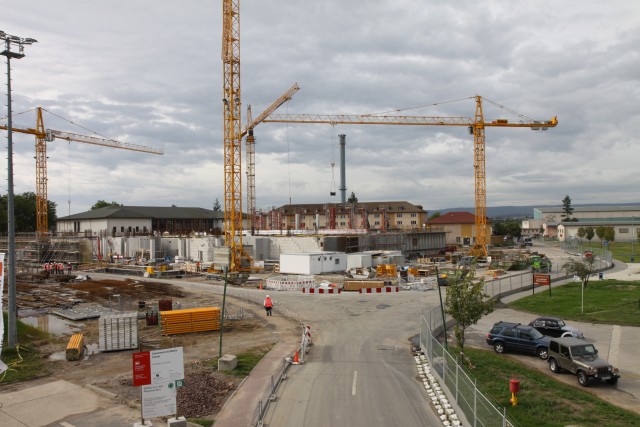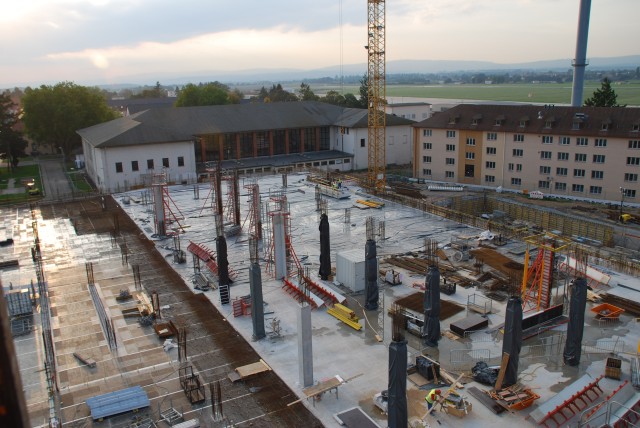WIESBADEN, Germany -- Not only will the U.S. Army Europe's future headquarters house the latest technology when it opens its doors in 2012, the Command and Battle Center will also boast the Army's first LEED Silver certification in Germany.
Even with the challenges posed by simultaneous design and construction, numerous change requests, and fully incorporating Leadership in Energy and Environmental Design to ensure LEED Silver certification as well as a quality product, the 285,000-square-foot facility is on schedule, according to Bryce Jones, a project engineer for the U.S. Army Corps of Engineers Europe District.
"Currently, we're finalizing design and working with M+W Group to submit all required paperwork for the LEED design phase credits," he said.
Other challenges include the multiple direct and indirect projects being conducted within the same project area, as well as familiarizing new contractors with their role in the partnership and USACE business processes. All of which must be incorporated into the overall LEED plan for successful certification, said Danielle Yi, a USACE field office architect and scheduler.
"Our business processes focus on quality and safety while maintaining the schedule and budget," Jones said. "This sounds normal to a Corps employee, but our daily involvement in ensuring the balance among these four items is critical for success and often new for many international contractors."
The sustainable features designed into the building will not only help reduce the Army's environmental "bootprint," they will also provide a healthier work environment for building occupants, said Rich Gifaldi, the district's sustainable engineering manager.
For instance, erosion and sedimentation control during construction is a common practice in the states. This consists of protecting storm drains with a layer of fabric called silt fencing to filter soil out of draining water. Additionally, soil stockpiles are seeded to prevent wind erosion and roads are consistently swept to keep trucks from moving dirt off site.
The center will be the first project here to require this practice, Gifaldi said.
"These measures reduce pollution by keeping soil out of nearby facilities, vehicles and crops, and reduce sediment from building up in streams or other water channels," he said. "This is a huge partnering effort from the field staff, both the USACE employees and the German contractors."
Along similar lines, contractors are utilizing an indoor air quality plan that protects materials to be used as well as contractors who work inside the building, and designers are incorporating water savings both inside and outside the building. Not only do architects estimate water savings of 30 percent or more through the use of water-efficient fixtures throughout the building, no potable water will be used for landscaping.
And to verify all mechanical, electrical and plumbing systems are installed and functioning as designed and intended, commissioning will be done on all systems, Gifaldi said.
"Otherwise, we could end up wasting energy and even risk early equipment breakdown," he said. "It's just another layer of checks that pays off in the long term."
Other ways the team is working to meet LEED requirements include its goals to obtain about 20 percent of construction materials from within 500 miles of the job site and recycle at least 75 percent of waste, said Tim Anderson, a district construction control representative.
"During construction in Germany, it's normal to separate and recycle construction waste. LEED just takes this one step further with documentation," Gifaldi said. "And by obtaining materials closer to the construction site, we're reducing CO2 emissions as well as supporting the local economy."
A 2008 USACE policy mandated the implementation of LEED standards in all fiscal year 2008 and later Army military construction projects, but attaining LEED certificates overseas has been a challenge for the Europe District.
"LEED refers back to U.S. standards and measurements," Gifaldi said. "Here, we are required to use German designers and German standards. Although many times German standards meet and even exceed U.S. standards, it takes a lot of extra work with the contractors to document LEED requirements."
The key to meeting these requirements, said Anderson, is addressing LEED as early as possible - preferably in the initial planning charrette and the Biddability, Constructability, Operability and Environmental process.
"We conduct weekly LEED quality inspections and monthly LEED adherence meetings to review the status of each credit we're aiming for and ensure our construction team, design team and LEED experts are all in sync," he said.
Even more, everyone involved in the project needs to be educated on LEED requirements, Gifaldi said - the project managers, construction representatives, future building occupants, German designers and contractors.
In addition to the Command and Battle Center, the district is also aiming to meet LEED Silver requirements for a child development center in Schinnen, Netherlands, which is on track for LEED Silver. The NATO administrative headquarters and SHAPE elementary, middle and high school buildings in Mons, Belgium, are also aiming for LEED Silver.
But the Command and Battle Center will serve as an example that LEED can work on projects in Germany, Gifaldi said.
"This is a huge effort, and the contractor, designers and Corps field staff are really key to making this work," he said. "We have to make sure that everyone at the table understands what's needed to push these projects through the end of certification and keep them on the right track. The more people are aware of the requirements, the easier it is to implement."
Related Links:
USACE, IMCOM training gives essential guidance on carrying out construction projects in Germany
USACE engineers in Europe LEED the way with green building projects






Social Sharing